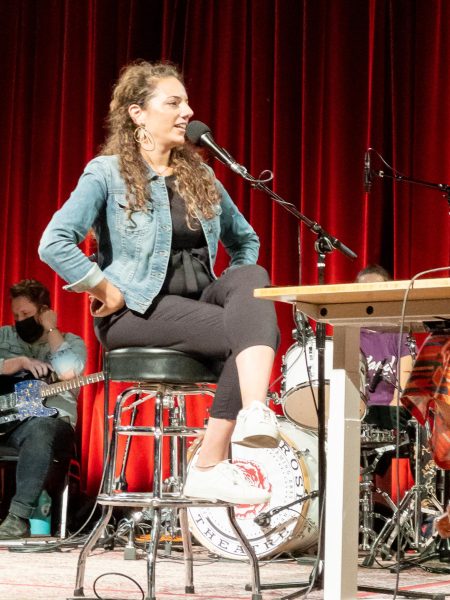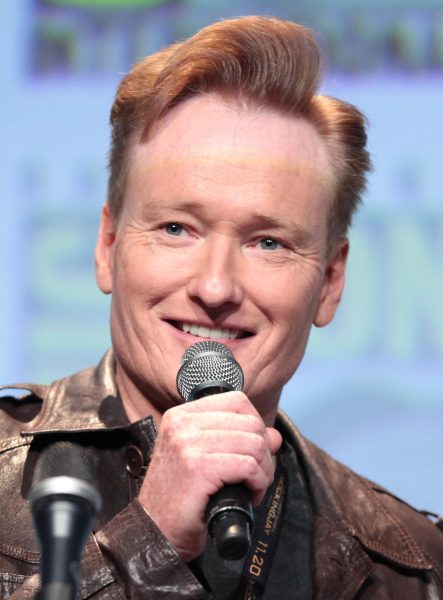As a New Yorker, people always find it odd how fond I am of Boston. In the sports world, my friends mock me for my adoration of Tom Brady. However, my love for the city extends to the second-most-famous person from Brookline, Massachusetts: Conan O’Brien.
Conan’s style is hard to describe. He graduated summa cum laude from Harvard, and has an impressive mind, but Conan constantly distances himself from that world. Yet, his humor often delves into extreme silliness, something Conan himself has characterized as pure stupidity. During the final episode of Conan, his TBS show that ran from 2010 to 2021, O’Brien described his style: “I’ve devoted all of my adult life — all of it — to pursuing this strange, phantom intersection between smart and stupid.”
This outlook has generated a distinct fan base, attracted to and infatuated by O’Brien’s outlandish content. After taking over in 1993, Conan and his first head writer, Robert Smigel, intended to create their brand of comedy: bombastic, irreverent, and unfased by current events. That is not to say that Conan never became political, but especially in the Trump-era late night scene, he definitely kept his distance.
“You can’t parody something that already has that crazy irregular shape. It’s not possible. So I always thought that when Trump came along, what a lot of people have to revert to is, ‘Doesn’t he suck? I hate that guy’….And those aren’t jokes,” remarked O’Brien surrounding the political comedy of the Trump-era.
Ironically, O’Brien considers himself an amateur historian; many of those infatuations find their way into his skits. Among his most famous “remotes” (sketches in which Conan and his staff travel to a given place to film a piece) are an “Old Timey Baseball” sketch, in which Conan visits Bethpage and its 1860’s accurate baseball. They play in original period costumes, reenacting the game with the equipment of centuries ago. Another extremely popular remote sees Conan become a Civil War re-enactor. Dressed in full Union blue, complete with attached mutton chops and several jokes about bringing modern hand lotion and granola bars to the battlefield, O’Brien thrives in these historical environments.
For example, Conan visits Springfield, Illinois, the hometown and final resting place of Abraham Lincoln, encountering impersonators. He compiles six different Lincoln impersonators, interviewing them all while bringing in his own Mary Todd to rival the one already present. Except his Mary Todd is very clearly not dressed in 1800s garb, much to Conan’s delight.
These field pieces reinforce the straightforward mission with which Conan entered the world of late night: make the kind of comedy you want to make, and the audience will follow. That goal is much easier said than done, as the nature of television ratings and network executives make creative products harder to sell. That said, O’Brien, along with head writer Robert Smigel, accomplished his goal of replacing David Letterman’s Late Night not with a replica, but a revamped version of his own. Conan’s rendition ran from 1993 until 2009, when he briefly took over The Tonight Show. After a squabble with NBC worthy of an entirely new article (several video essays on YouTube tell it best, or see ABC’s recap), Conan departed mainstream late night and joined basic cable at TBS.
His mission remained the same there: make silly comedy that appeals to virtually nobody. In fact, during Conan’s interview with American Masters PBS, he discusses his favorite comedians and sketches. Many of his idols follow the same trend: there is no real audience for them. They are comedians who make material for themselves, bringing a genuine joy to the content that seldom appears in the performative work in the late-night sphere (CBS, NBC, and ABC; and I like Kimmel, Meyers, and Colbert).
These sentiments remind me of several Conan sketches, but one personal favorite remains “Fix This Mug.” Written by two of O’Brien’s career-long writers, Andrés du Bouchet and Dan Cronin, the segment is bizarre. Really bizarre. But I think the group of creative minds who wrote it would appreciate that description. It features Brian Stack, one of Conan’s regular sketch performers and writers for twenty years, playing a day-one intern named Gary who glues together Conan’s mug. In doing so, he employs an industrial drill and, eventually, passes away in the line of duty. That is absurd enough; what transpires afterwards is pure chaos. The fake cast comes out to commemorate him with an oddly well-planned funeral, complete with a musical performance from a group of elementary-school children whom Stack’s character helped through philanthropic work. The final act, however, sees a tribute video to Gary in which the three leads dress in full Viking attire and participate in an 80’s-style synthesizer song.
If that makes no sense, you are a sane individual. But that’s kind of the point. There is no merit to that bit; it is purely for the enjoyment of the creators. It finds its audience, sure (I am here after all), but it’s definitely not intended for a specific group. There is something beautiful about this brand of comedy, which is unabashedly genuine and creative.
O’Brien’s work on television has transitioned better than anticipated to the podcast medium. Despite my affinity for the absurdly silly sketches that became the essence of Conan, his podcast relishes in a more down-to-earth comedic approach. Conan and his two sidekicks, dubbed the ‘Chill Chums,’ who are podcasting expert and self-proclaimed comedian Matt Gourley, and Conan’s long-time personal assistant (famous for appearing on his show as well as doing nothing during working hours) Sona Movsesian, who sit around a table and just riff. O’Brien flexes his muscles as a true master of improv comedy, creating bits out of thin air.

The guests are almost always entertaining, and Conan’s pedigree and career makes for fascinating discussions with a broad spectrum of people. From the normal cast of famous comedians and actors (Adam Sandler, Kaley Cuoco, Will Arnett, and Paul Rudd, among others) to legendary writers Robert Smigel and Jim Downey, his podcast allows for silliness on a smaller scale, and it is comedy gold. Furthermore, Conan’s love for music extends his podcast to include guests like Dave Grohl and Questlove. This adds an extra dimension to his creative, improv-centric, long-forum work.
The podcast is so good, in fact, that it spurred an HBO spin-off entitled Conan O’Brien Must Go. It centers around guests on Conan’s biweekly podcast Conan O’Brien Needs A Fan, a spinoff of the main podcast where fans call in to speak to Conan. The show follows O’Brien as he traverses the globe surprising some of the podcast guests.
Conan has expressed his love for travel exhaustively, and some of his most beloved work among fans came when he did travel shows for TBS. With TBS, he went to Italy, Haiti, and Armenia to name a few of the countries he visited; and this show sees him go to Norway, Ireland, and Thailand. O’Brien is in his element when he makes others the very opposite: his interviews of stoic Norwegians who admonish his cartoonish attire which he purchased from a traditional clothing store are a prime example.

I am not sure that O’Brien really needs another profile; after all, his interviews with The Rolling Stone or PBS will tell his story much better than myself. However, I think part of Conan’s magic is how he has evolved. When he took over for Letterman in the 90s, Conan was hardly a struggling individual. His writing credentials for Saturday Night Live and The Simpsons reveal a fairly successful career in comedy. However, he was a writer, and that separated him from the likes of Carson and Leno. Not being a household name when he started meant both challenges and rare creative freedom.
On The Howard Stern Show, Conan reflected on his early days and the criticism that followed. He recalls Tom Shales, the top television critic, issuing a scathing and brutal rebuke of O’Brien’s style and show. That could have tanked the show; but through that, Conan maintained what would become a sort of trademark optimism. At a commencement address at Dartmouth following his squabble with and departure from NBC, O’Brien insisted on that same perspective:
“In 2000, I told graduates to not be afraid to fail, and I still believe that. But today I tell you that whether you fear it or not, disappointment will come. The beauty is that through disappointment you can gain clarity, and with clarity comes conviction and true originality.”
I suppose I began this piece with the intent of reviewing the podcast, so maybe I should get to that more. Forgive me: I could talk about Conan all day long, and my dad is tired of it, so I needed a new medium. The podcast, as mentioned earlier, is a fresher, different side of Conan. He is not rehearsed (or at least it doesn’t seem that way), and the formality of the late-night format is gone. This allows O’Brien to excel both as an interviewer and an improviser. In the podcasting format, O’Brien’s hour-long interviews interspersed with riffs between his co-hosts make for entertaining and witty content.
To be fair, Conan was early into the podcasting game, and Conan’s role as an innovator is not limited to the podcast. Many of his shows’ clips appeared on YouTube long before his fellow hosts found their way to the streaming site. O’Brien has attributed his longer-lasting prominence and constantly evolving fanbase to the Internet. For a comedian that entered the public eye more than thirty years ago, a large contingent of his fans are millennials and younger people.
Conan O’Brien is an idol of mine (that should be pretty clear by now); clearly he does not need more press or recognition. But seeing as this is my final contribution to The Science Survey before I head off to college this fall, I wanted to leave behind some Conan lore.
During the final episode of Conan, his TBS show that ran from 2010 to 2021, O’Brien described this style: “I’ve devoted all of my adult life — all of it — to pursuing this strange, phantom intersection between smart and stupid.”

